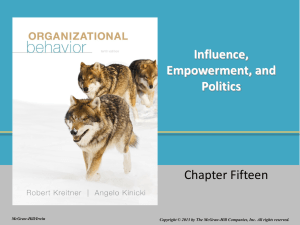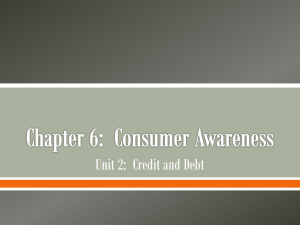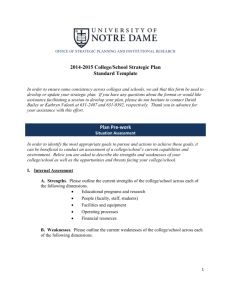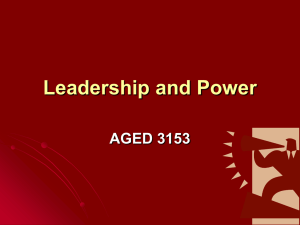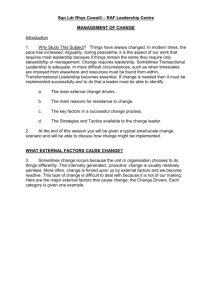Study Guide to Go - Cengage Learning
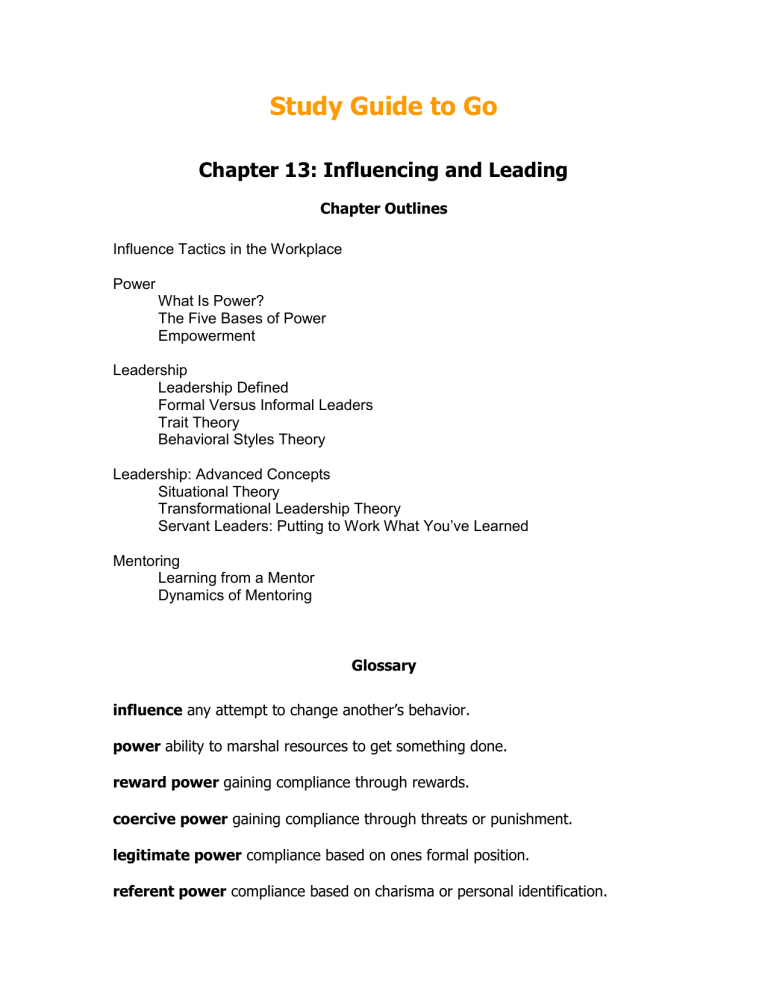
Study Guide to Go
Chapter 13: Influencing and Leading
Chapter Outlines
Influence Tactics in the Workplace
Power
What Is Power?
The Five Bases of Power
Empowerment
Leadership
Leadership Defined
Formal Versus Informal Leaders
Trait Theory
Behavioral Styles Theory
Leadership: Advanced Concepts
Situational Theory
Transformational Leadership Theory
Servant Leaders: Putting to Work What You’ve Learned
Mentoring
Learning from a Mentor
Dynamics of Mentoring
Glossary
influence any attempt to change another’s behavior.
power ability to marshal resources to get something done.
reward power gaining compliance through rewards.
coercive power gaining compliance through threats or punishment.
legitimate power compliance based on ones formal position.
referent power compliance based on charisma or personal identification.
expert power compliance based on ability to dispense valued information.
empowerment making employees full partners in the decision-making process and giving them the necessary tools and rewards.
leadership social influence process involving inspiring and guiding others in a common effort.
formal leadership the process of influencing others to pursue official objectives.
informal leadership the process of influencing others to pursue unofficial objectives.
emotional intelligence the ability to monitor and control ones emotions and behavior in complex social settings.
transformational leaders visionaries who challenge people to do exceptional things.
mentor someone who develops another person through tutoring, coaching, and guidance.
Learning Objective Summary
Learning Objective 1: Identify and describe eight generic influence tactics used in modern organizations.
• Recent research has identified eight generic influence tactics that people use on the job:
- Consultation (Seeking someone’s participation in a decision or change)
- Rational persuasion (Trying to convince someone by relying on a plan, reasoning, or logic)
- Inspirational appeals (Appealing to someone’s emotions, values, or ideals to generate enthusiasm and confidence)
- Ingratiating tactics (Making someone feel important or good before making a request)
- Coalition tactics (Seeking the aid of others to persuade someone to agree)
- Pressure tactics (Relying on intimidation, demands, or threats to gain compliance or support)
- Upwards appeals (Obtaining support of higher management)
- Exchange tactics (Offering an exchange of favors or a personal sacrifice)
Learning Objective 2: Identify the five bases of power, and explain what it takes to make empowerment work.
• The five bases of power are:
- Reward (Gaining compliance through rewards)
- Coercive (Gaining compliance through threats or punishment)
- Legitimate (Compliance based on one’s formal position)
- Referent (Compliance based on charisma or personal identification)
- Expert (Compliance based on ability to dispense valued information)
• Empowerment cannot work without a supporting situation such as a skilled individual; an organizational culture of empowerment; an emotionally mature individual with a well-developed character; and empowerment opportunities such as delegation, participation, and self-managed teams.
Learning Objective 3: Explain the concept of emotional intelligence in terms of Goleman’s four leadership traits, and summarize what the
Ohio State model and the Leadership Grid® have taught managers about leadership.
• Goleman’s trait approach identifies four dimensions of emotional intelligence: self-awareness, self-management, social awareness, and relationship management. Managers with emotional intelligence (the ability to cope with pressures and demands in a mature fashion) can build needed social capital in today’s workplaces.
• Leadership studies at Ohio State University isolated four styles of leadership based on two categories of leader behavior: initiating structure and consideration. Despite the claim that the high-structure, high consideration leadership style is the single best style, convincing research evidence is lacking.
• The Leadership Grid® has taught managers that a high concern for both production and people achieves better results.
Learning Objective 4: Contrast the assumptions behind Fiedler’s contingency theory and path-goal leadership theory, and describe transformational and servant leaders.
• Many years of study led Fiedler to conclude that task-motivated leaders are more effective in either very favorable or very unfavorable situations, whereas relationship-motivated leaders are better suited to moderately favorable situations. The favorableness of a situation is dictated by the degree of the leader’s control and influence in getting the job done.
• Path-goal leadership theory, an expectancy perspective, assumes that leaders are effective to the extent that they can motivate followers by clarifying goals and clearing the paths to achieving those goals and valued rewards. Unlike
Fiedler, path-goal theorists believe that managers can and should adapt their leadership style to the situation.
• Transformational leaders are visionaries who challenge people to do exceptional things and servant leaders are ethical people who put others first.
Learning Objective 5: Identify the two key functions that mentors perform, and explain how a mentor can help develop a junior manager’s leadership skills.
• Mentors help develop less experienced people by fulfilling five career functions
(sponsorship, exposure and visibility, coaching, protection, and challenging assignments) and four psychosocial functions (role modeling, acceptance and confirmation, counseling, and friendship).
• Mentors serve as role models and engage in intensive tutoring, coaching, and guidance of junior managers.
Test Preppers
Test Prepper 13.1
True or False?
_____ 1. An “exchange tactic” is one of the generic influence tactics.
_____ 2. The eight generic influence tactics involve downward, but not upward, influence.
_____ 3. According to researchers, there are no systematic gender-based differences in influencing others.
Multiple Choice
_____ 4. Which of these is text? not among the generic influence tactics described in the a. Upward appeals b. Exchange tactics c. Consultation d. Participative tactics e. Coalition tactics
_____ 5. _____ refers to making someone feel important or good before making a request. a. The coalition tactic b. Consultation c. The ingratiating tactic d. An upward appeal e. An inspirational appeal
_____ 6. Employees tend to use which of these with participative managers? a. Coalition tactics b. Rational persuasion c. Consultation d. Ingratiating tactics e. Exchange tactics
Test Prepper 13.2
True or False?
_____ 1. Managers who have power automatically have authority.
_____ 2. Based on threatened or actual punishment, coercive power is one of the five bases of power.
_____ 3. Managers with reward power are said to have charisma.
Multiple Choice
_____ 4. By definition, the word a. fear. power centers on b. telling people what to do. c. actually getting something done. d. formal authority. e. one’s social position.
_____ 5. Authority is the _____ to direct others, while power is the _____. a. duty; right b. right; ability c. right; responsibility d. duty; responsibility e. obligation; right
_____ 6. A car dealer who promises an extra one-week vacation for the top seller at the end of the year is relying on which of the five bases of power? a. Reward b. Economic c. Coercive d. Procedural e. Referent
_____ 7. _____ power closely parallels formal authority. a. Traditional b. Referent c. Functional d. Rational
e. Legitimate
_____ 8. What advice does the former head of the Girl Scouts of America, Frances
Hesselbein, offer to managers who want to increase their power? a. Power corrupts. b. Avoid being power hungry. c. Position equals power. d. Powerful leaders have loyal followers. e. Give more power away.
Test Prepper 13.3
True or False?
_____ 1. As defined, informal leaders are a serious threat to the organization’s mission.
_____ 2. Leaders who rely on kindness and humor to build strong relationships possess
Goleman’s “relationship management” trait.
_____ 3. According to Judy B. Rosener’s survey, male leaders were found to be worse at sharing power and information than were their female counterparts.
_____ 4. The laissez-faire leadership style involves retention of authority and responsibility by the leader.
_____ 5. The two dimensions of leadership in the Ohio State model are consideration and initiating structure.
_____ 6. On the Leadership Grid®, the 9,1 style is referred to as authority-compliance.
Multiple Choice
_____ 7. _____ leadership is the process of influencing relevant others to pursue official organizational objectives. a. Informal b. Ad hoc c. Decentralized d. Intermittent e. Formal
_____ 8. Which of these is the newest approach in the evolution of leadership theory? a. Transformational b. Behavioral styles c. Virtual d. Trait e. Situational
_____ 9. An array of non-cognitive skills, capabilities, and competencies that influence a person’s ability to cope with environmental demands and pressures refers to
a. self-management. b. emotional intelligence. c. behavior modification. d. empowerment. e. IQ.
_____ 10. What did a comprehensive review of research have to say about male and female leadership styles? a. There is a significant difference in leadership styles exhibited by women and men. b. Female leaders are more authoritarian than male leaders. c. Male leaders are better at sharing power than female leaders. d. Research is inconclusive about this issue. e. There is no significant difference in leadership styles exhibited by women and men.
_____ 11. The word _____ best characterizes “consideration” in the Ohio State leadership model. a. trust b. goals c. results d. techniques e. authority
_____ 12. On the Leadership Grid®, the _____ leadership style correlates positively with better results and better physical and mental health. a. 1,9 b. 9,9 c. 1,1 d. 9,1 e. 5,5
Test Prepper 13.4
True or False?
_____ 1. According to Fiedler’s contingency theory of leadership, a leader’s effectiveness depends on both the situation and his or her motivation.
_____ 2. Relationship-motivated leaders tend to be effective when the situation is highly favorable, according to Fiedler’s theory.
_____ 3. According to path-goal theory, there is one best style of leadership that applies in all situations.
_____ 4. Management by exception is a favorite technique for transactional leaders.
_____ 5. Servant leaders put the company’s survival ahead of people.
Multiple Choice
_____ 6. According to Fiedler’s contingency theory, _____ leaders tend to perform better when the situation is _____ favorable. a. relationship-motivated; moderately b. visionary; highly c. achievement-oriented; moderately d. social; highly e. task-motivated; moderately
_____ 7. The path-goal theory of leadership is based on a. Goleman’s EQ theory. b. goal-setting theory. c. McGregor’s Theory Y. d. expectancy theory. e. Herzberg’s two-factor theory.
_____ 8. Which leader behavior, according to the pathgoal theory, involves being approachable while showing concern for employees’ well-being? a. Achievement-oriented b. Directive c. Participative d. Supportive e. Transformational
_____ 9. What do transformational leaders such as Southwest Airline’s former CEO Herb
Kelleher rely heavily on? a. Transactional power b. Legitimate power c. Reward power d. Expert power e. Referent power
_____ 10. Which of the following is a characteristic of a transactional leader? a. Individualized consideration b. Intellectual stimulation c. Inspiration d. Laissez-faire e. Charisma
_____ 11. In Greenleaf’s servant-leadership theory, the center of attention is on a. others. b. God. c. the customer. d. top management. e. the mission.
Test Prepper 13.5
True or False?
_____ 1. Mentors develop another person’s abilities through tutoring, coaching, and guidance.
_____ 2. According to research, the practice of formally assigning mentors tends to be the most effective approach.
_____ 3. Role modeling is one of the psychosocial functions of mentoring.
_____ 4. One way a mentor can serve a career function is to provide challenging assignments.
Multiple Choice
_____ 5. Which role parallels the concept of a mentor? a. Master b. Confessor c. Student d. Servant e. Coach
_____ 6. According to researchers, mentor relationships average about which length of time? a. No identifiable time frame b. Five years c. Six months d. One year e. Lifetime
_____ 7. _____ is a career function of mentors. a. Indoctrination b. Sponsorship c. Role modeling d. Friend e. Socialization
_____ 8. Which of the following is a psychosocial function of mentoring? a. Protection b. Sponsorship c. Exposure d. Counseling e. Challenging assignments
Test Prepper Answer Key
13.1
1. T 2. F 3. T 4. d 5. c 6. b
13.2
1. F 2. T 3. F 4. c 5. b 6. a 7. e 8. e
13.3
1. F 2. T 3. T 4. F 5. T 6. T 7. e 8. a 9. b 10. e 11. a 12. b
13.4
1. T 2. F 3. F 4. T 5. F 6. a 7. d 8. d 9. e 10. d 11. a
13.5
1. T 2. F 3. T 4. T 5. e 6. b 7. b 8. d

